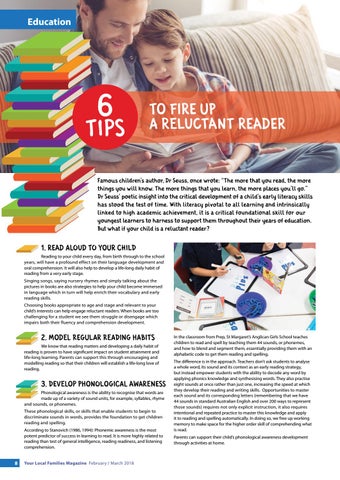Education
6
TIPS
TO FIRE UP A RELUCTANT READER
Famous children’s author, Dr Seuss, once wrote: “The more that you read, the more things you will know. The more things that you learn, the more places you’ll go.” Dr Seuss’ poetic insight into the critical development of a child’s early literacy skills has stood the test of time. With literacy pivotal to all learning and intrinsically linked to high academic achievement, it is a critical foundational skill for our youngest learners to harness to support them throughout their years of education. But what if your child is a reluctant reader?
1. READ ALOUD TO YOUR CHILD Reading to your child every day, from birth through to the school years, will have a profound effect on their language development and oral comprehension. It will also help to develop a life-long daily habit of reading from a very early stage. Singing songs, saying nursery rhymes and simply talking about the pictures in books are also strategies to help your child become immersed in language which in turn will help enrich their vocabulary and early reading skills. Choosing books appropriate to age and stage and relevant to your child’s interests can help engage reluctant readers. When books are too challenging for a student we see them struggle or disengage which impairs both their fluency and comprehension development.
2. MODEL REGULAR READING HABITS We know that reading matters and developing a daily habit of reading is proven to have significant impact on student attainment and life-long learning. Parents can support this through encouraging and modelling reading so that their children will establish a life-long love of reading.
3. DEVELOP PHONOLOGICAL AWARENESS Phonological awareness is the ability to recognise that words are made up of a variety of sound units, for example, syllables, rhyme and sounds, or phonemes. These phonological skills, or skills that enable students to begin to discriminate sounds in words, provides the foundation to get children reading and spelling. According to Stanovich (1986, 1994): Phonemic awareness is the most potent predictor of success in learning to read. It is more highly related to reading than test of general intelligence, reading readiness, and listening comprehension.
8
Your Local Families Magazine February / March 2018
In the classroom from Prep, St Margaret’s Anglican Girls School teaches children to read and spell by teaching them 44 sounds, or phonemes, and how to blend and segment them, essentially providing them with an alphabetic code to get them reading and spelling. The difference is in the approach. Teachers don’t ask students to analyse a whole word, its sound and its context as an early reading strategy, but instead empower students with the ability to decode any word by applying phonics knowledge and synthesising words. They also practise eight sounds at once rather than just one, increasing the speed at which they develop their reading and writing skills. Opportunities to master each sound and its corresponding letters (remembering that we have 44 sounds in standard Australian English and over 200 ways to represent those sounds) requires not only explicit instruction, it also requires intentional and repeated practice to master this knowledge and apply it to reading and spelling automatically. In doing so, we free up working memory to make space for the higher order skill of comprehending what is read. Parents can support their child’s phonological awareness development through activities at home.
